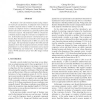Free Online Productivity Tools
i2Speak
i2Symbol
i2OCR
iTex2Img
iWeb2Print
iWeb2Shot
i2Type
iPdf2Split
iPdf2Merge
i2Bopomofo
i2Arabic
i2Style
i2Image
i2PDF
iLatex2Rtf
Sci2ools
FGR
2008
IEEE
2008
IEEE
Biased discriminant analysis using composite vectors for eye detection
We propose a new discriminant analysis using composite vectors for eye detection. A composite vector consists of a number of pixels inside a window on an image. The covariance of composite vectors is obtained from their inner product and can be considered as a generalized form of the covariance of pixels. The proposed C-BDA is a biased discriminant analysis using the covariance of composite vectors. In the hybrid cascade detector constructed for eye detection, Haar-like features are used in the earlier stages and composite features obtained from C-BDA are used in the later stages. The experimental results for the CMU and Yale databases show that the proposed detector provides robust performance to several kinds of variations such as facial pose, illumination, and closed eyes. In particular, it provides a 99.4% detection rate for the CMU images without glasses.
| Added | 29 May 2010 |
| Updated | 29 May 2010 |
| Type | Conference |
| Year | 2008 |
| Where | FGR |
| Authors | Chunghoon Kim, Matthew Turk, Chong-Ho Choi |
Comments (0)

